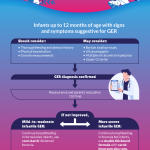Regurgitations are the effortless returns of gastric contents through the esophagus and out of the mouth. Gastroesophageal reflux (GER) is defined as the passage of gastric content into the esophagus with or without regurgitation and vomiting1.
This may cause acid exposure, responsible of the burning sensations. The prevalence of regurgitations in infants younger than 12 months varies from 3% to 87%2.
Regurgitations can be physiologic and can be aggravated through several factors: lying position, abdominal compression, important volume of feeding, liquid foods. They can also be a symptom of another disease such as cow’s milk allergy3.
When GER leads to severe symptoms and/or complications that affect daily functioning, it is called GERD (Gastroesophageal Reflux Disease).
High volumes of regurgitations returned with force may lead to other important issues such as feeding difficulties, growth disorders, etc1. Experts recommend thickened feed for treating visible regurgitation/vomiting, including infants with GERD1.
1. Rosen R., et al., Pediatric Gastroesophageal Reflux Clinical Practice Guidelines: Joint Recommendations of the North American Society for Pediatric Gastroenterology, Hepatology, and Nutrition and the European Society for Pediatric Gastroenterology, Hepatology, and Nutrition. JPGN 66: 516–554 (2018).
2. Vandenplas Y., et al., Prevalence and Health Outcomes of Functional Gastrointestinal Symptoms in Infants From Birth to 12 Months of Age. JPGN 61: 531–537 (2015).
3. Salvatore S., & Vandenplas,Y., Gastroesophageal reflux and cow milk allergy: is there a link? Pediatrics 110, 972–984 (2002).

Novalac solution
Lorem ipsum dolor sit amet, consectetur adipiscing elit. Hendrerit risus gravida eros
Novalac solution
Lorem ipsum dolor sit amet, consectetur adipiscing elit. Hendrerit risus gravida eros
Novalac solution
Lorem ipsum dolor sit amet, consectetur adipiscing elit. Hendrerit risus gravida eros
Explore more in Regurgitations
Novalac AR clinical efficacy
What do guidelines say?
Bone fracture in children: what’s behind it?

Diagnosis and management of infantile GER
